欧洲及中国NCAP新标准体系介绍_090508
锂离子电池新欧标
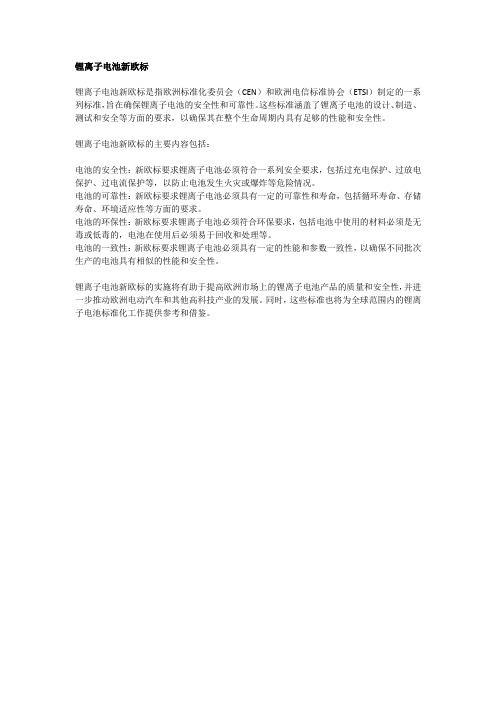
锂离子电池新欧标
锂离子电池新欧标是指欧洲标准化委员会(CEN)和欧洲电信标准协会(ETSI)制定的一系列标准,旨在确保锂离子电池的安全性和可靠性。
这些标准涵盖了锂离子电池的设计、制造、测试和安全等方面的要求,以确保其在整个生命周期内具有足够的性能和安全性。
锂离子电池新欧标的主要内容包括:
电池的安全性:新欧标要求锂离子电池必须符合一系列安全要求,包括过充电保护、过放电保护、过电流保护等,以防止电池发生火灾或爆炸等危险情况。
电池的可靠性:新欧标要求锂离子电池必须具有一定的可靠性和寿命,包括循环寿命、存储寿命、环境适应性等方面的要求。
电池的环保性:新欧标要求锂离子电池必须符合环保要求,包括电池中使用的材料必须是无毒或低毒的,电池在使用后必须易于回收和处理等。
电池的一致性:新欧标要求锂离子电池必须具有一定的性能和参数一致性,以确保不同批次生产的电池具有相似的性能和安全性。
锂离子电池新欧标的实施将有助于提高欧洲市场上的锂离子电池产品的质量和安全性,并进一步推动欧洲电动汽车和其他高科技产业的发展。
同时,这些标准也将为全球范围内的锂离子电池标准化工作提供参考和借鉴。
欧标认证标准-概述说明以及解释

欧标认证标准-概述说明以及解释1.引言1.1 概述欧标认证标准旨在为欧洲市场提供一致性和安全性保证,确保产品和服务能够满足欧洲各国的法律和技术要求。
这些标准由欧洲标准化委员会(CEN)和欧洲电子通信标准化协会(ETSI)等组织制定和管理。
欧标认证标准是在全球范围内广泛接受和采用的标准之一,其作用不仅限于欧洲市场。
许多国家和地区都将欧标认证标准作为产品和服务质量的重要指标,以确保产品的可靠性、安全性和互操作性。
因此,获得欧标认证标准对于拓展产品和服务的国际市场至关重要。
欧标认证标准涵盖了多个领域,包括建筑材料、电子设备、医疗器械、食品安全、环境保护等。
这些标准旨在规范产品的设计、制造、测试和质量控制过程,确保其符合相应的法律法规和技术要求。
通过遵循这些标准,企业能够提高产品的质量和可靠性,减少风险和责任。
欧标认证标准的制定过程是透明、开放和协作的。
各利益相关方包括政府机构、行业协会、消费者组织和企业都可以参与到标准的制定和修订中。
这种合作机制确保了标准的科学性、可信度和普适性。
对于企业而言,获得欧标认证标准不仅能够提高其产品的竞争力,还能够增加消费者的信任和忠诚度。
同时,符合欧标认证标准的产品还能够降低市场准入的障碍,进一步拓宽企业的出口市场。
尽管欧标认证标准对企业来说具有诸多好处,但其认证过程也需要企业付出相应的努力和资源。
企业需要与认证机构合作,进行产品测试和评估,确保其产品符合相关的标准要求。
此外,企业还需要进行定期的质量管理体系审核和更新,以保持认证的有效性。
总之,欧标认证标准在欧洲和全球范围内具有重要的地位和作用。
它不仅为企业提供了国际市场竞争的优势,也为消费者提供了可靠和安全的产品和服务。
随着全球经济一体化的深入发展,欧标认证标准将继续发挥其引领和规范的作用,推动各国产品和服务贸易的便利化和互联互通。
1.2 文章结构文章将按照以下结构展开进行阐述:1. 引言:首先,文章将对欧标认证标准的概述进行介绍,概括说明文章涉及的主题以及相关的背景信息。
欧洲NCAP 系统介绍及试验和评分方法

如图 1 所示,欧洲 NCAP 体系中采用正面 40%重 叠撞击可变形壁障的方式进行试验,40%重叠指车身 最宽处的 40%,撞击速度为 64km/h,与 ECER94 及 GB11551 的区别见表 1。
试验前 如果可调,将离合器踏板、制动踏板、加 速踏板和方向盘调至中间位置或厂商推荐的适合混 合III型假人的位置。标记离合器踏板、制动踏板和 加速踏板的中心;去除方向盘罩盖或气囊模块,露 出转向管柱顶端并标记。拆除行李箱中的备胎、塑 料件和橡胶密封条等(可能影响行李箱门锁的应装 回)。将坐标参考架如图3.1所示安装在车辆后部中 间。测量并记录参考架支点的高度。此高度在试验
验。其中,40%重叠的正面偏置碰撞试验与 ECE R94 和我国的 GB11551 试验有很多相同之处,可变形移 动壁障侧面碰撞试验与我国即将颁布的侧面碰撞试 验要求等同,柱碰试验也与我国即将颁布的侧面碰 撞试验要求有很多相似之处。因此,这里只对区别 之处加以研究。 3.1 正面碰撞 3.1.1 碰撞方式
扣上成人安全带扣,在腰带外侧安装一个力传 感器,在约束系统和 B 柱间的肩带上装一个力传感 器。使肩带和腰带的张力达到 50+-5N。若有,使用 锁止装置。如果 CRS 的设计可以保持肩带和腰带的 张力,去除肩带张力传感器。若去除张力传感器会
NCAP五大测试标准比较

中国美国日本欧洲NCAP五大测试标准比较NCAP是最早在美国开展并已经在欧洲、日本等发达国家运行多年的新车评价规程,一般由政府或具有权威性的组织机构,按照比国家法规更严格的方法对在市场上销售的车型进行碰撞安全性能测试、评分和划分星级,向社会公开评价结果。
由于这样的测试公开、严格、客观,为消费者所关心,也成为汽车企业产品开发的重要规范,对提高汽车安全性能作用显著。
近年,更多国家(如澳大利亚、韩国、印度等)开始重视和建立本国的NCAP。
严格的试验条件是保证评价结果客观准确的重要前提,因此,国外NCAP试验室普遍都具备高水平的测试设备和专业能力。
但是,各国NCAP在组织实施方式、试验规程和评分方法上都有明显不同,这与各国在法规体系、道路交通事故统计和车辆状况等方面存在的差异密切相关。
显然,盲目照搬国外做法来建立中国的NCAP是缺乏科学分析基础和不切实际的。
以下是几种最常见到的NCAP测试与中国的C-NCAP测试标准的比较。
从图表上看,日本、中国、美国以及欧洲的撞击测试标准有同有异。
我国的C-NCAP据了解,中国汽车技术研究中心在深入研究和分析国外NCAP 的基础上,结合我国的汽车标准法规、道路交通实际情况和车型特征,并进行广泛的国内外技术交流和实际试验确定了C-NCAP的试验和评分规则。
与我国现有汽车正面和侧面碰撞的强制性国家标准相比,不仅增加了偏置正面碰撞试验,还在两种正面碰撞试验中在第二排座椅增加假人放置,以及更为细致严格的测试项目,技术要求也非常全面。
C-NCAP对试验假人及传感器的标定、测试设备、试验环境条件、试验车辆状态调整和试验过程控制的规定都要比国家标准更为严谨和苛刻,与国际水平一致。
标准正面,侧面测试C-NCAP正面100%和40%的撞击测试速度上较欧洲NCAP(下称“E-NCAP”)以及美国高速公路保险协会IIHS的测试速度还有所不及。
C-NCAP的侧面撞击速度与日本NCAP(下称“J-NCAP”)和美国公路交通安全管理局NHTSA的侧面速度标准也相差达10%.而在行人安全方面,E-NCAP和J-NCAP都有做测试,甚至在考虑儿童座椅和安全性能上面两种测试标准都有非常细致的体现。
欧洲ncap标准
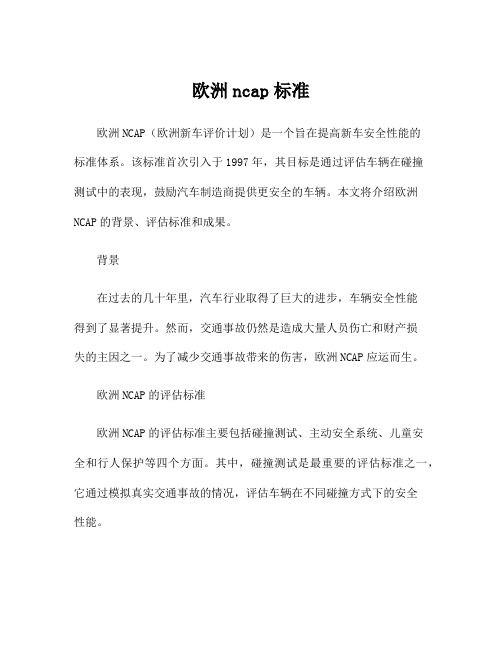
欧洲ncap标准欧洲NCAP(欧洲新车评价计划)是一个旨在提高新车安全性能的标准体系。
该标准首次引入于1997年,其目标是通过评估车辆在碰撞测试中的表现,鼓励汽车制造商提供更安全的车辆。
本文将介绍欧洲NCAP的背景、评估标准和成果。
背景在过去的几十年里,汽车行业取得了巨大的进步,车辆安全性能得到了显著提升。
然而,交通事故仍然是造成大量人员伤亡和财产损失的主因之一。
为了减少交通事故带来的伤害,欧洲NCAP应运而生。
欧洲NCAP的评估标准欧洲NCAP的评估标准主要包括碰撞测试、主动安全系统、儿童安全和行人保护等四个方面。
其中,碰撞测试是最重要的评估标准之一,它通过模拟真实交通事故的情况,评估车辆在不同碰撞方式下的安全性能。
碰撞测试主要包括正面碰撞、侧面碰撞和侧翻测试。
其中,正面碰撞测试是模拟车辆与前方障碍物相撞的情况,评估车辆的乘员保护能力。
侧面碰撞测试是模拟车辆被侧面撞击的情况,评估车辆的侧面保护能力。
侧翻测试是评估车辆在侧翻事故中的稳定性。
除了碰撞测试,欧洲NCAP还评估车辆的主动安全系统,如紧急制动系统、车道保持辅助系统和盲点监测等。
这些系统可以帮助驾驶员避免碰撞和减少事故的发生。
此外,欧洲NCAP还关注儿童安全和行人保护。
评估儿童安全主要通过测试儿童座椅的安全性能,以及汽车是否配备了儿童安全锁和儿童安全座椅固定装置。
评估行人保护主要通过模拟车辆与行人相撞的情况,评估车辆对行人的保护能力。
欧洲NCAP的成果欧洲NCAP的实施取得了显著的成果。
自从标准首次引入以来,汽车制造商竞相改进车辆的安全性能。
根据欧洲NCAP公布的评估结果,消费者能够更清晰地了解不同车型的安全性能。
这促使汽车制造商设计和生产更安全的车辆,并加速了车辆安全技术的发展。
同时,欧洲NCAP还鼓励消费者购买更安全的汽车。
通过评估和比较不同车型的安全性能,消费者可以更好地了解和选择最适合自己需求的车辆。
这一机制激励了汽车制造商提高车辆的安全性能,保护了消费者的权益。
c-ncap评价标准

C-NCAP评价标准、C-NCAP评价标准主要包括以下三个方面:试验项目,性能指标与评分办法,得分与星级评价,下面一一介绍。
1.试验项目1.1正面100%重叠刚性壁障碰撞试验试验车辆100%重叠正面冲击固定刚性壁障,壁障上附以20mm厚胶合板。
碰撞速度为50-51km/h(试验速度不得低于50km/h)。
试验车辆到达壁障的路线在横向任一方向偏离理论轨迹均不得超过150mm。
在前排驾驶员和乘员位置分别放置一个Hybrid III型第50百分位男性假人,用以测量前排人员受伤害情况。
在第二排座椅最左侧座位上放置一个Hybrid III型第5百分位女性假人,最右侧座位上放置一个P系列3岁儿童假人,用以测量第二排人员受伤害情况。
若车辆第二排座椅ISOFIX固定点仅设置于左侧,可以将女性假人放置的位置与儿童约束系统及儿童假人调换。
对于两门单排座车型,仅在前排驾驶员和乘员位置分别放置一个Hybrid III型第50百分位男性假人,用以测量前排人员受伤害情况。
1.2正面40%重叠可变形壁障碰撞试验试验车辆40%重叠正面冲击固定可变形壁障。
碰撞速度为63-65km/h,偏置碰撞车辆与可变形壁障碰撞重叠宽度应在40%车宽±20mm的范围内。
在前排驾驶员和乘员位置分别放置一个Hybrid III型第50百分位男性假人,用以测量前排人员受伤害情况。
在第二排座椅最左侧座位上放置一个Hybrid III型第5百分位女性假人,用以测量第二排人员受伤害情况。
对于两门单排座车型,仅在前排驾驶员和乘员位置分别放置一个Hybrid III型第50百分位男性假人,用以测量前排人员受伤害情况。
在试验中需测量A柱、转向管柱和踏板变形量。
1.3可变形移动壁障侧面碰撞试验在移动台车前端加装可变形蜂窝铝,移动壁障行驶方向与试验车辆垂直,移动壁障中心线对准试验车辆R点,碰撞速度为50-51km/h(试验速度不得低于50km/h)。
移动壁障的纵向中垂面与试验车辆上通过碰撞侧前排座椅R点的横断垂面之间的距离应在±25mm内。
欧洲ncap标准

欧洲ncap标准
欧洲新车评估计划(European New Car Assessment Program,简称Euro NCAP)是一个独立的汽车安全评价组织,致力于推动汽车安全标准的提高。
以下是欧洲NCAP标准的主要内容:
1. 碰撞测试:欧洲NCAP对汽车进行碰撞测试,包括正面碰撞、侧面碰撞和侧面撞击测试。
这些测试旨在评估车辆在不同碰撞情况下乘员的保护能力。
2. 行人保护:欧洲NCAP还评估汽车在行人碰撞中的保护能力,包括前部碰撞测试和行人踏板测试。
这些测试旨在评估车辆对行人的保护程度。
3. 辅助安全系统:欧洲NCAP评估车辆所配备的辅助安全系统的性能和效果,包括自动紧急制动系统、车道保持辅助系统、盲点监测系统等。
这些系统的存在与性能会影响车辆的安全性。
4. 儿童乘员保护:欧洲NCAP对车辆的儿童乘员保护能力进行评估,包括儿童座椅的安装和固定性能、正面和侧面碰撞时对儿童的保护程度等。
5. 安全辅助系统:欧洲NCAP评估车辆所配备的安全辅助系统的性能和效果,包括智能限速系统、酒精检测装置、疲劳驾驶监测系统等。
这些系统在提高驾驶员安全性方面发挥重要作用。
欧洲ncap标准 安全辅助
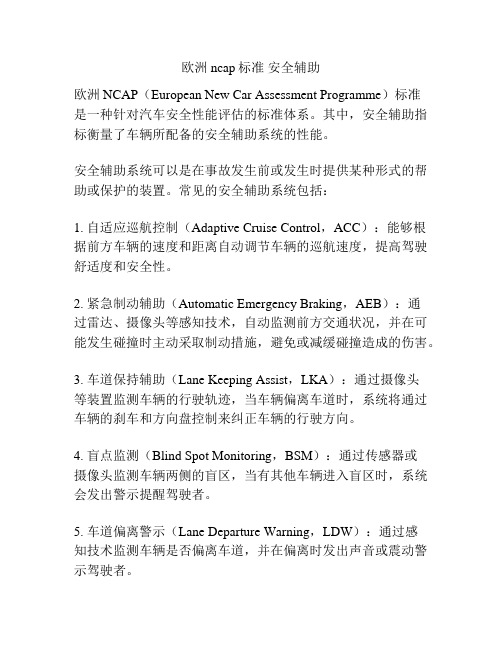
欧洲ncap标准安全辅助
欧洲NCAP(European New Car Assessment Programme)标准
是一种针对汽车安全性能评估的标准体系。
其中,安全辅助指标衡量了车辆所配备的安全辅助系统的性能。
安全辅助系统可以是在事故发生前或发生时提供某种形式的帮助或保护的装置。
常见的安全辅助系统包括:
1. 自适应巡航控制(Adaptive Cruise Control,ACC):能够根据前方车辆的速度和距离自动调节车辆的巡航速度,提高驾驶舒适度和安全性。
2. 紧急制动辅助(Automatic Emergency Braking,AEB):通
过雷达、摄像头等感知技术,自动监测前方交通状况,并在可能发生碰撞时主动采取制动措施,避免或减缓碰撞造成的伤害。
3. 车道保持辅助(Lane Keeping Assist,LKA):通过摄像头
等装置监测车辆的行驶轨迹,当车辆偏离车道时,系统将通过车辆的刹车和方向盘控制来纠正车辆的行驶方向。
4. 盲点监测(Blind Spot Monitoring,BSM):通过传感器或
摄像头监测车辆两侧的盲区,当有其他车辆进入盲区时,系统会发出警示提醒驾驶者。
5. 车道偏离警示(Lane Departure Warning,LDW):通过感
知技术监测车辆是否偏离车道,并在偏离时发出声音或震动警示驾驶者。
这些安全辅助系统在提高驾驶舒适性的同时,还能够减少由于驾驶错误或疏忽引起的事故风险,提高乘车安全性。
根据这些安全辅助系统的性能表现,欧洲NCAP评估会对车辆的安全辅助得分进行评估和发布。
这有助于消费者在购买车辆时更好地了解车辆的安全性能。
euro-ncap测试标准2023

euro-NCAP是欧洲新车评级计划(European New Car Assessment Programme)的缩写,它是欧洲国家间合作的结果,旨在为用户提供有关汽车安全性能的信息。
Euro-NCAP测试车辆在其碰撞、车辆安全系统和儿童乘客保护等方面的表现,以确保用户可以在购物汽车时获得最准确的信息。
1. Euro-NCAP测试标准的背景Euro-NCAP的标准在不断发展,以适应现代汽车生产技术的进步。
其中包括新型车辆安全系统的出现,以及用户对汽车安全性能的需求不断提高。
2023年的新测试标准将更加注重车辆的主动安全系统,以及对全新的评级标准的引入和更新。
2. 主动安全系统的测试随着科技的不断进步,汽车的主动安全系统也得到了极大的发展。
2023年的Euro-NCAP测试标准将更加注重对这些系统的评价,包括自动紧急制动系统(AEB)、车道保持系统、盲点监测系统、自动跟车巡航控制系统等。
这些系统对于提高驾驶员和乘客的安全性能非常重要,因此对其进行全面的测试和评价,对汽车的安全性能有着非常重要的意义。
3. 新型评级标准的引入和更新Euro-NCAP将不断更新和完善其评级标准,以适应汽车行业的发展,并更好地反映用户对汽车安全性能的需求。
2023年的新测试标准将更加注重对车辆在碰撞中的表现,不仅包括乘员与车辆撞击后的保护,还将更加涉及对行人保护的考量。
这些新的评级标准将使用户更能够了解汽车的综合安全性能,避免事故发生时对乘员和行人的伤害。
4. Euro-NCAP在行业中的影响Euro-NCAP测试标准的不断提高和更新,对汽车行业产生了积极的影响。
它鼓励汽车制造商不断改进和升级汽车的安全性能,提升汽车的整体质量。
它也促使汽车制造商在设计和生产车辆时更加注重主动安全系统的配置和使用,并更加重视车辆在碰撞中的表现,这对用户的安全意识和安全驾驶有着重要的促进作用。
5. 结语Euro-NCAP测试标准的不断提高和更新,对于用户、汽车制造商以及整个汽车行业来说都具有重要的意义。
欧盟认证标准
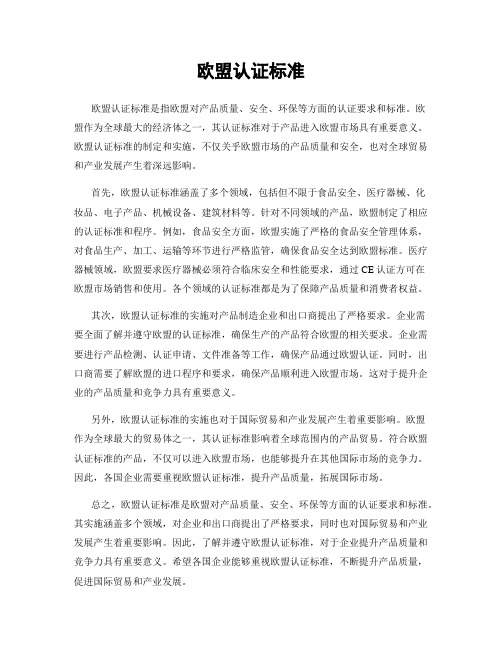
欧盟认证标准欧盟认证标准是指欧盟对产品质量、安全、环保等方面的认证要求和标准。
欧盟作为全球最大的经济体之一,其认证标准对于产品进入欧盟市场具有重要意义。
欧盟认证标准的制定和实施,不仅关乎欧盟市场的产品质量和安全,也对全球贸易和产业发展产生着深远影响。
首先,欧盟认证标准涵盖了多个领域,包括但不限于食品安全、医疗器械、化妆品、电子产品、机械设备、建筑材料等。
针对不同领域的产品,欧盟制定了相应的认证标准和程序。
例如,食品安全方面,欧盟实施了严格的食品安全管理体系,对食品生产、加工、运输等环节进行严格监管,确保食品安全达到欧盟标准。
医疗器械领域,欧盟要求医疗器械必须符合临床安全和性能要求,通过CE认证方可在欧盟市场销售和使用。
各个领域的认证标准都是为了保障产品质量和消费者权益。
其次,欧盟认证标准的实施对产品制造企业和出口商提出了严格要求。
企业需要全面了解并遵守欧盟的认证标准,确保生产的产品符合欧盟的相关要求。
企业需要进行产品检测、认证申请、文件准备等工作,确保产品通过欧盟认证。
同时,出口商需要了解欧盟的进口程序和要求,确保产品顺利进入欧盟市场。
这对于提升企业的产品质量和竞争力具有重要意义。
另外,欧盟认证标准的实施也对于国际贸易和产业发展产生着重要影响。
欧盟作为全球最大的贸易体之一,其认证标准影响着全球范围内的产品贸易。
符合欧盟认证标准的产品,不仅可以进入欧盟市场,也能够提升在其他国际市场的竞争力。
因此,各国企业需要重视欧盟认证标准,提升产品质量,拓展国际市场。
总之,欧盟认证标准是欧盟对产品质量、安全、环保等方面的认证要求和标准。
其实施涵盖多个领域,对企业和出口商提出了严格要求,同时也对国际贸易和产业发展产生着重要影响。
因此,了解并遵守欧盟认证标准,对于企业提升产品质量和竞争力具有重要意义。
希望各国企业能够重视欧盟认证标准,不断提升产品质量,促进国际贸易和产业发展。
euro-ncap 2023新测评规程

《2023年欧洲新车评估计划(Euro-NCAP)新测评规程解读》一、引言近年来,汽车安全性成为了消费者购车时日益重要的考量因素之一,而欧洲新车评估计划(Euro-NCAP)作为一项公认的汽车安全性评估标准,其测试和评估结果也直接影响着消费者的购车选择。
而在2023年,Euro-NCAP将会出台全新的车辆评估规程,预计也将对汽车行业产生重大影响。
本文就将对2023年Euro-NCAP新测评规程进行深入分析和解读,希望能给您带来一些有价值的信息。
二、评估范围及新增要求2023年Euro-NCAP新测评规程在评估范围和新增要求上进行了多项调整。
新规程将更加注重对车辆主动安全系统的评测,包括自动驾驶辅助系统(ADAS)的性能评估以及车辆对行人和自行车骑手的保护性能。
在事故预防和事故保护性能方面也将进行更为严格和全面的评估,特别是在侧面碰撞和追尾碰撞方面的表现。
三、全面评估带来的影响相比之前的规程,2023年的新测评规程将在深度和广度上带来更全面的评估,对车辆的安全性能有着更高的要求。
在评估过程中,不仅会对车辆的 passively 安全性进行评估,还会更加关注车辆的主动安全性,这将对汽车制造商提出更高的技术挑战。
另外,这也将给消费者提供更为全面和深入的车辆安全性能信息,有助于他们做出更明智的购车选择。
四、个人观点和理解从我个人的观点来看,2023年Euro-NCAP新测评规程的全面评估对汽车行业来说是一次挑战,但也是一次机遇。
汽车制造商需要在技术研发和安全性能方面进行更多的投入,这将推动整个行业的发展和进步。
消费者也将从全面评估中受益,能够更好地了解车辆的安全性能,为自己和家人的出行安全提供更可靠的保障。
五、总结总体来说,2023年Euro-NCAP新测评规程将对汽车行业和消费者产生深远影响。
全面的评估将促使汽车制造商不断提升车辆的安全性能,同时也将使消费者更好地了解和选择安全性能更好的汽车。
我相信这项新规程的出台将为整个行业带来更高的安全标准,为消费者提供更可靠的汽车选择。
欧洲NCAP评分标准
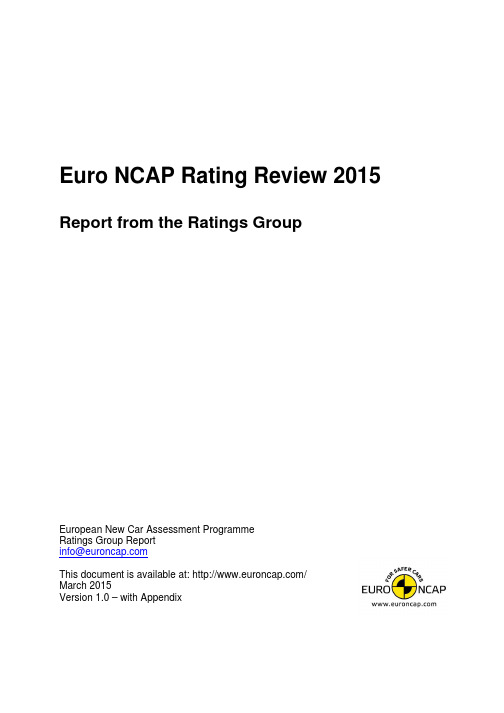
Euro NCAP Rating Review 2015 Report from the Ratings GroupEuropean New Car Assessment ProgrammeRatings Group Reportinfo@This document is available at: /March 2015Version 1.0 – with AppendixTable of Contents (2)Preface (3)Abbreviations (4)Introduction (5)Background (5)Objectives (5)Guiding Principles (7)Lessons Learnt (7)Active versus Passive Safety (7)Rating Plan (9)Preface (9)2016 (9)2018 (10)2020 (11)Dual Rating Policy (11)Beyond 2020 (12)Further Remarks (13)IWI (13)Heavy Vehicles (13)Pole Test (13)Acknowledgements (14)Appendix (15)Summary points tables (15)Rating scheme thresholds and weights (16)Euro NCAP | 2This document explains how the strategic items presented in Euro NCAP’s “Roadmap 2020” will be included into the Rating Scheme from 2016 onwards.The content of this document reflects the discussions held at the Ratings Group meetings between July 2014 and February 2015 and takes into account input from various stakeholders inside as well as outside the group.Euro NCAP | 3AOP Adult Occupant ProtectionAEB Autonomous Emergency Braking in City (AEB City) and Interurban scenarios (AEB Interurban)AEB VRU Autonomous Emergency Braking for Vulnerable Road Users,including Pedestrians (AEB VRU-Pe) & Cyclists (AEB VRU-Cy)C-ITS Cooperative – Intelligent Transport SystemsCOP Child Occupant ProtectionCRS Child Restraint SystemESC Electronic Stability ControlFW Full WidthIWI Information, Warning and InterventionLDW Lane Departure WarningLKA LSS Lane Keep Assist Lane Support SystemODB Offset Deformable Barrier PP Pedestrian ProtectionSA Safety AssistSAS SBR Speed Assistance SystemSeat Belt ReminderEuro NCAP | 4BackgroundIn June 2014, Euro NCAP announced its plans for how it will further develop the 5 star overall safety rating system over the next years. New goals and priorities have been set for updating the assessment programme in order to promote and reward continued safety improvements in vehicles on the European market.The rating of key advanced driver assistance and crash avoidance systems form the backbone of the strategy as this plays an essential role in the proliferation of new technology and guides improved capability at the same time. The “Roadmap 2020” logically builds upon the topics that were implemented since 2009 when the overall rating was first introduced. For the first time, however, it places these in the context of emerging vehicle automation.The roadmap promotes systems that help the driver to drive safely, avoid crashes with other road users and to mitigate the consequences of unavoidable accidents: robust systems that road users can rely on and are effective in the real world. The technical solutions that are chosen and how best to develop and integrate these systems should be left to the vehicle manufacturers.For this reason, the rating criteria and thresholds set by Euro NCAP should preferably be neutral and based on performance rather than design or hardware. The weight in the star rating for a given safety function should be linked to its expected potential to reduce crashes and/or mitigate injuries on European roads. This shows how challenging a task it is to define future rating targets for the next generation of systems, whose technical performance, market availability, test limitations, driver acceptance etc. can only be assumed.ObjectivesThe Ratings Group was re-instated in the summer of 2014 to define the detailed rating scheme for the period up to 2020 based on the roadmap. As part of the work, the group reviewed the rating scheme of Euro NCAP to date, including the updates already announced for 2016, and proposed a rationale and method for implementing new items based on accident evidence and market intelligence. Performance thresholds were defined for each star level, based on the results of recently tested cars combined with projections of future performance.It is believed that the resulting rating scheme is challenging yet feasible, allowing vehicles in all classes, budget to premium, to be able to achieve 5 stars. Importantly, it will reward those car manufacturers who continue to prioritise safety. This way, the rating stays meaningful to consumers and fleet operators who are looking for objective guidance for their next purchase.Euro NCAP | 5This report contains the detailed targets, points and percentages for the years 2016 up to 2020. The allocated points will serve as goal posts to the technical committees responsible for setting the limits and sliding scales on future criteria.As the underlying protocols and assessment criteria are under development or, in other instances, are still not known, the numbers in this report will need to be checked and confirmed closer to the date of implementation. This is particularly true for the years 2018 to 2020.Finally, Euro NCAP encourages car manufacturers to continue to put forward Euro NCAP Advanced dossiers on their latest technologies to enhance the knowledge base and to allow for a better understanding of the safety potential offered by the newest generation of systems on the market.Table 1. Representatives in Euro NCAP’s Rating GroupAndre Seeck (Chair) BASt Pierre Castaing UTACAled Williams (Secretary) Euro NCAP Anders Lie STAMichiel van Ratingen Euro NCAP Volker Sandner ADACRichard Schram Euro NCAP Ronald Vroman ICRTAndrew Miller Thatcham Joaquim Huguet IDIADAMatthew Avery Thatcham Henry Gutman CSIEuro NCAP | 6Lessons LearntThe experience of the last several years has helped shape the thinking about how the future rating scheme should continue to evolve. The system, which combines crash protection and crash avoidance into a single star rating, has been flexible and robust enough to allow for annual updates, many of which were substantive. As hoped, the vehicle industry has demonstrated that it can meet the demands by skilful engineering and the introduction of advanced technology on their latest models.The original intention of a single star rating covering all aspects of a car’s safety was that the message to consumers could remain relatively simple and straightforward. However, this has been challenged by the year on year changes to the rating scheme and the decreasing number of 5 star cars over recent years, despite the fact that cars have, on average, got safer during this period. The outcome of this is that, while the overall rating is a powerful and very effective instrument to promote safer vehicles, greater care must be taken to ensure that the system is stable over the coming years. This stability has been achieved firstly by creating more constancy in box i limits and by planning safety improvements mainly via protocol content updates. Secondly, the weighting factors between boxes have been left unchanged from 2014 for the entire period up to 2020. Lastly, important changes to the rating scheme have been clustered in the years 2016, 2018 and 2020 instead of the annual updates. This means that for a few exceptional cases, the timing of the introduction of new or revised protocols as indicated in the “Roadmap 2020” has been slightly altered ii.Active versus Passive SafetySubstitutionMost of the new content is related to active safety or accident avoidance rather than to passive safety. As before, points are attributed to assessments in boxes based on their expected safety potential, the current state-of-the-art in system performance and test restrictions. The limitations of today’s avoidance systems and the general lack of real world evidence do not justify substitution of passive safety by active safety in the rating scheme at this time. Therefore, where both avoidance and crash related protocols are combined in one box, a minimum performance in passive safety is still required to be eligible for the active safety points.Target SettingTo meet future crash avoidance requirements, identifying a sensor strategy that delivers the best possible value for the consumer is not a simple question. In the short term,i Euro NCAP scores vehicle performance in four main areas (the so-called boxes): Adult Occupant Protection (AOP), Child Occupant Protection (COP), Pedestrian Protection (PP) and Safety Assist (SA).ii An updated “Roadmap 2020” (Revision 1, March 2015) document is available online.Euro NCAP | 7target setting at Euro NCAP should not favour any specific hardware solution whether it is sensor fusion, radar-only or camera-only systems. Instead, target levels are set to deliver key safety functions, allowing an appropriate level of balance and trade-off by the manufacturer. By setting thresholds carefully, only well-equipped cars will become eligible for 5 and 4 stars, while 3 star cars offer “5 star” passive safety only.From 2018 onwards, it is expected that 5 star cars gradually would need to demonstrate higher levels of crash avoidance performance. To achieve this, a multi-sensor solution would be required. Finally, the next generation of systems that will emerge in the years 2020 and after will offer even higher performance.System FitmentFrom 2016 Euro NCAP only allows standard safety equipment on the tested variant to generate the “base” rating. The vehicle manufacturer can request a second (“dual”) rating with optional active safety systems included, provided these are offered as a safety pack on all variants in all European markets. The safety pack must be installed on 25 percent and 55 percent of model sales calculated over the first and second three year periods of sales, respectively. Which optional technologies are eligible for inclusion in the safety pack is detailed in the next chapter for each publication year.Euro NCAP | 8PrefaceBelow, the ratings plan for the years 2016-2020 is outlined, more specially for the years 2016, 2018 and 2020. In the intermediate years, no major updates are planned and the targets will carry over from the preceding year. An overview of points, weights, overall criteria and balance criteria limits for all years is presented in the Appendix to this report.2016Scheduled content updatesChild Occupant Protection– Update to the child occupant protection protocol to include Q6 and Q10 child dummies; simplified requirements for CRS installation and vehicle based assessment.Pedestrian Protection – Introduction of the assessment of AEB systems for Vulnerable Road Users (AEB VRU-Pe) in crossing scenarios.Safety Assist – Removal of ESC points from the box. Introduction of a lane support test (rewarding LKA and LDW systems) and updated SAS requirements.Rating schemeTable 2. 2016 Points allocationAOP (40%) COP (20%) PP (20%) SA (20%)8 Front ODB 24 Dynamic tests 24 Head forms 3 SBR8 Front FW 12 CRS installation 6 Upper leg form 3 SAS8 Side barrier 13 Vehicle based 6 Lower leg form 3 LKA/LDW8 Side pole3 AEB City 6 AEB VRU-Pe 3 AEB Interurban3 Whiplash F/R38 Total available 49 Total available 42 Total available 12 Total available Notes(a) The total points for PP increase from 36 (for subsystem performance only) to 42.Only vehicles that achieve a score of 22 points or higher in the subsystem tests can gain up to 6 points for AEB VRU-Pe.(b) Allocated points for Dynamic tests in COP and SAS in SA remain the same.(c) Points related to LKA and LDW performance increase from 1 to 3. This may includean incentive for availability of blind spot systems.ThresholdsThe Balance thresholds for AOP, PP and SA are adjusted to get better resolution in the middle star bands, amongst other reasons. Detailed limits are provided in the Appendix.Euro NCAP | 92018Scheduled content updatesAdult Occupant Protection – Far-side protection incentive added to the side barrier test. Revised Whiplash seat assessment procedure and broadened AEB City test scenarios.Pedestrian Protection – Extension of the assessment of AEB systems for Vulnerable Road Users with pedal cyclist scenarios (AEB VRU-Cy) and update of pedestrian tests with longitudinal scenario.Safety Assist – Updated SBR assessment, broadened test suite for AEB Interurban to improve system robustness and “best practice” IWI strategy (see also page 13). Implementation of an advanced lane support system (LSS) test including road edge detection systems.Rating schemeTable 3. 2018 Points allocationAOP (40%) COP (20%) PP (20%) SA (20%)8 Front ODB 24 Dynamic tests 24 Head forms 3 SBR8 Front FW 12 CRS installation 6 Upper leg form 3 SAS8 Side barrier 13 Vehicle based 6 Lower leg form 4 LSS8 Side pole4 AEB City 6 AEB VRU-Pe 3 AEB Interurban2 Whiplash F/R 6 AEB VRU-Cy38 Total available 49 Total available 48 Total available 13 Total availableNotes(a) The head protection in side impact will be assessed based on the worst performingresult in near and far side impact criteria (linked to 4 protocol points, or 2 overall points in the box). The total number of points for the side barrier test is unaffected.(b) Rebalancing of points between Whiplash F/R assessment and AEB City alongsidethe update in technical requirements. “Good” performance in the front seat test remains a condition for AEB City scoring.(c) The total points for PP increase from 42 to 48. Only vehicles that achieve a score of22 points or higher in the subsystem tests can gain up to 6 points for AEB VRU-Peand/or AEB VRU-Cy.(d) SBR will keep 3 points associated. Of these points, 2 points will be for rear seat SBRincluding ½ point for advanced occupant sensing systems.(e) Points allocated to the assessment of advanced Lane Support Systems increasefrom 3 to 4. AEB Interurban updates will not aim at addressing significantly different crash scenarios (e.g. no braking in head-on scenarios) so the points remain the same.ThresholdsThe Balance thresholds for SA and COP are adjusted as system performance is expected to improve. Detailed limits are provided in the Appendix.Euro NCAP | 102020Scheduled content updatesAdult Occupant Protection– Replacing the ODB test with an off-set mobile barrier test specifying an advanced frontal dummy.Safety Assist – Adoption assessment of technology that can assist in junction (crossing and turning) and head-on scenarios.Rating schemeTable 4. 2020 Points allocationAOP (40%) COP (20%) PP (20%) SA (20%)8 Front ODB 24 Dynamic tests 24 Head forms 3 SBR8 Front FW 12 CRS installation 6 Upper leg form 3 SAS8 Side barrier 13 Vehicle based 6 Lower leg form 4 LSS8 Side pole4 AEB City 6 AEB VRU-Pe 4 AEB Interurban2 Whiplash F/R 6 AEB VRU-Cy 2 Junction assist38 Total available 49 Total available 48 Total available 16 Total available Notes(a) The 16 points available for front impact are divided between the new mobile barriertest (8 points) and current FW test (8 points).(b) SA total points increase from 13 to 16 points with the extension of AEB Interurbanand inclusion of Junction Assist.ThresholdsAll thresholds remain the same. Detailed limits are provided in the Appendix.Dual Rating PolicyFor each publication year, a dual rating may be requested for vehicles that offer at least one of the listed technologies as part of an optional safety pack, available on all variants.2016 2017 2018 2019 2020 2021 2022 AEB City(a)x x xAEB Interurban x x xAEB VRU-Pe x x x x xAEB VRU-Cy x x x x x Junction Assist x x x LKA/LDW/LSS(b)x x x x xSAS(c)x x xNotes(a) Only if sensor technology used also supports other safety functions.(b) From 2018, only LSS including road edge detection.(c) From 2017, only for systems that offer the ISA functionality.Euro NCAP | 11Beyond 2020Safety technology will continue to evolve in the years to come as emerging vehicle automation takes the next big steps forwards. The upcoming C-ITS technology, combined with vehicle automation, will create new opportunities to further reduce the number of crashes in traffic.Euro NCAP will monitor and stimulate the development and market availability of key technology such as C-ITS and driver monitoring systems for inclusion into the rating scheme from 2020 onwards.Euro NCAP | 12In the previous chapter the preferred scenario for inclusion of roadmap items in the rating scheme has been presented. Below some final remarks are made to compliment the information already provided.IWIIn many of the emerging safety systems, the driver behaviour plays an important role. Driver reactions to warnings and acceptance of the systems in general may determine to a large extent how effective these systems are in real traffic. Euro NCAP has started a dialog with industry regarding the information, warning and intervention (IWI) strategy related to safety functions. It intends to develop general guidelines that will support the relevant protocols implemented from 2018 onwards.Heavy VehiclesAs of 2016, vans and people carriers will be rated under an identical scheme as passenger cars. Minor protocol exemptions are provided as detailed in the Heavy Vehicles Test and Assessment Protocol Version 2.0 (or later). The validity of the rating applied to vans is set for 6 years, similar to passenger cars. Two additional years of protection against retesting are given to accommodate the longer life cycle of this category of vehicles.Pole TestEuro NCAP has made the pole test a manufacturer sponsored test in 2015. The intention is to continue to use pole test data in the rating of the vehicle but to allow the assessment to be done on the basis of third party or car manufacturer’s data, no later than such time that the pole test will be performed on all new vehicles as part of European type approval.Euro NCAP | 13The members of the Euro NCAP Rating Group would like express their gratitude towards the industry representatives who provided input in the process.Euro NCAP | 14To be included in the base rating, all safety equipment (passive and active) must be fitted as standard across EU-28. See the “Vehicle Specification, Sponsorship, Testing and Retesting” (VSSTR) protocol for more information about test variants.Summary points tablesAdult Occupant ProtectionTest 2016 2017 2018 2019 2020Frontal ODB / Mobile barrier 8 8 8 8 8Frontal FW 8 8 8 8 8Side MDB 8 8 8 8 8Side pole 8 8 8 8 8Whiplash front 2 2 1.5 1.5 1.5Whiplash rear 1 1 0.5 0.5 0.5AEB City 3 3 4 4 4Total 38 38 38 38 38Child Occupant ProtectionTest 2016 2017 2018 2019 2020Dynamic performance 24 24 24 24 24Vehicle-CRS compatibility 12 12 12 12 12Vehicle based assessment 13 13 13 13 13Total 49 49494949Pedestrian ProtectionTest 2016 2017 2018 2019 2020Headforms 24 24 24 24 24Upper Legform 6 6 6 6 6Lower Legform 6 6 6 6 6AEB VRU-Pe 6 6 6 6 6AEB VRU-Cy 6 6 6Total 42 42 48 48 48Safety AssistTest 2016 2017 2018 2019 2020ESC - - - - -SBR 3 3 3 3 3SLD/SAS 3 3 3 3 3AEB (Interurban) 3 3 3 3 4LDW/LKD/LSS 3 3 4 4 4Junction Assist 2Total 12 12 13 13 16Euro NCAP | 15Rating scheme thresholds and weightsAOP COP PP SA Total 2016For five stars, at least: 80% 75% 60% 50% 69%For four stars, at least: 70% 60% 50% 40% 58%For three stars, at least: 60% 30% 40% 25% 43%For two stars, at least: 50% 25% 30% 15% 34%For one star, at least: 40% 15% 20% 10% 25%Weight 40% 20% 20% 20%2017For five stars, at least: 80% 75% 60% 50% 69%For four stars, at least: 70% 60% 50% 40% 58%For three stars, at least: 60% 30% 40% 25% 43%For two stars, at least: 50% 25% 30% 15% 34%For one star, at least: 40% 15% 20% 10% 25%Weight 40% 20% 20% 20%2018For five stars, at least: 80% 80% 60% 70% 74%For four stars, at least: 70% 70% 50% 60% 64%For three stars, at least: 60% 60% 40% 50% 54%For two stars, at least: 50% 50% 30% 40% 44%For one star, at least: 40% 40% 20% 30% 34%Weight 40% 20% 20% 20%2019For five stars, at least: 80% 80% 60% 70% 74%For four stars, at least: 70% 70% 50% 60% 64%For three stars, at least: 60% 60% 40% 50% 54%For two stars, at least: 50% 50% 30% 40% 44%For one star, at least: 40% 40% 20% 30% 34%Weight40% 20% 20% 20%2020For five stars, at least: 80% 80% 60% 70% 74%For four stars, at least: 70% 70% 50% 60% 64%For three stars, at least: 60% 60% 40% 50% 54%For two stars, at least: 50% 50% 30% 40% 44%For one star, at least: 40% 40% 20% 30% 34%Weight40% 20% 20% 20%Euro NCAP | 16。
ncap五星级标准的分数

NCAP五星级标准的分数引言随着汽车行业的发展,对汽车安全性能的要求也越来越高。
NCAP(新车安全评价计划)作为衡量汽车安全性能的国际标准,被广泛接受和采用。
在这篇文章中,我们将详细讨论NCAP五星级标准的分数,深入了解各个方面的评测指标和得分标准。
NCAP五星级评价体系NCAP五星级评价体系是一种用于评估汽车安全性能的方法,被广泛用于全球各地。
评价体系包含多个方面的指标,覆盖了车辆的主动安全系统、被动安全设计、安全辅助技术等方面。
根据车辆在不同测试项目中的表现,最终给予相应的评分,评分越高,车辆的安全性能越好。
主动安全系统评价1. 制动性能制动性能是评价车辆主动安全性能的重要指标之一。
NCAP评测中,通过在不同速度下制动测试,评估车辆的制动性能。
根据制动距离和制动力的表现,给予相应分数。
制动距离越短,制动力越大,得分越高。
2. 操控稳定性操控稳定性是评价车辆在不同路况下的稳定性能。
NCAP评测中,对车辆在不同路况下的操控性能进行测试,包括转向响应、侧倾稳定性等方面。
根据测试结果给予相应分数,操控性能越好,得分越高。
3. 防侧翻性能侧翻事故是一种常见的交通事故,评价车辆的防侧翻性能对于保障乘员的安全至关重要。
NCAP评测中,通过模拟侧翻事故进行测试,评估车辆的防侧翻性能。
根据车辆的侧翻角度和侧倾幅度给予相应分数,防侧翻性能越好,得分越高。
4. 可能性避撞性能可能性避撞性能是评价车辆在避免碰撞的能力。
NCAP评测中,通过模拟可能性避撞场景进行测试,评估车辆的避撞性能。
根据车辆的避撞响应、刹车响应等方面给予相应分数,避撞性能越好,得分越高。
被动安全设计评价1. 安全车身结构安全车身结构是保障车辆乘员安全的基础。
NCAP评测中,通过车身刚性测试和车身强度测试,评估车辆的安全车身结构。
根据车身的形变情况和最大承载力给予相应分数,安全车身结构越好,得分越高。
2. 碰撞安全性能碰撞安全性能是评价车辆在碰撞事故中的保护能力。
EuroNcap欧洲新车评价规范(中文版)
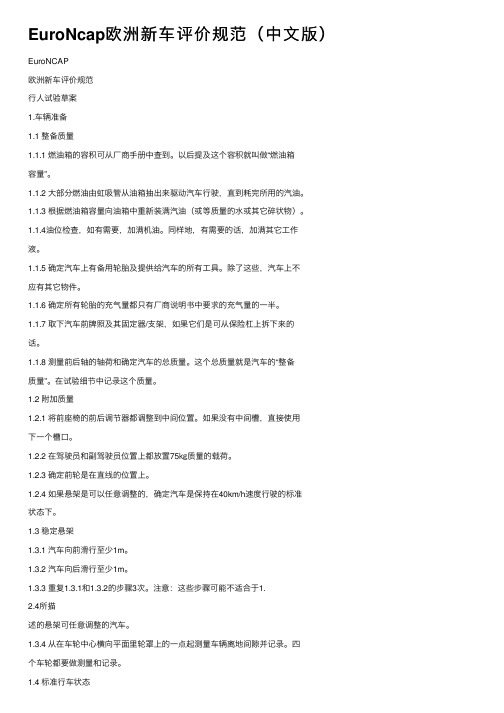
EuroNcap欧洲新车评价规范(中⽂版)EuroNCAP欧洲新车评价规范⾏⼈试验草案1.车辆准备1.1 整备质量1.1.1 燃油箱的容积可从⼚商⼿册中查到。
以后提及这个容积就叫做“燃油箱容量”。
1.1.2 ⼤部分燃油由虹吸管从油箱抽出来驱动汽车⾏驶,直到耗完所⽤的汽油。
1.1.3 根据燃油箱容量向油箱中重新装满汽油(或等质量的⽔或其它碎状物)。
1.1.4油位检查,如有需要,加满机油。
同样地,有需要的话,加满其它⼯作液。
1.1.5 确定汽车上有备⽤轮胎及提供给汽车的所有⼯具。
除了这些,汽车上不应有其它物件。
1.1.6 确定所有轮胎的充⽓量都只有⼚商说明书中要求的充⽓量的⼀半。
1.1.7 取下汽车前牌照及其固定器/⽀架,如果它们是可从保险杠上拆下来的话。
1.1.8 测量前后轴的轴荷和确定汽车的总质量。
这个总质量就是汽车的“整备质量”。
在试验细节中记录这个质量。
1.2 附加质量1.2.1 将前座椅的前后调节器都调整到中间位置。
如果没有中间槽,直接使⽤下⼀个槽⼝。
1.2.2 在驾驶员和副驾驶员位置上都放置75㎏质量的载荷。
1.2.3 确定前轮是在直线的位置上。
1.2.4 如果悬架是可以任意调整的,确定汽车是保持在40km/h速度⾏驶的标准状态下。
1.3 稳定悬架1.3.1 汽车向前滑⾏⾄少1m。
1.3.2 汽车向后滑⾏⾄少1m。
1.3.3 重复1.3.1和1.3.2的步骤3次。
注意:这些步骤可能不适合于1.2.4所描述的悬架可任意调整的汽车。
1.3.4 从在车轮中⼼横向平⾯⾥轮罩上的⼀点起测量车辆离地间隙并记录。
四个车轮都要做测量和记录。
1.4 标准⾏车状态1.4.1 经过以上步骤后,汽车就如在地⾯上正常⾏驶⼀样具有标准的⾏车状态,轮胎⽓压达到规定范围,前轮在中间位置,所有⼯作液都处于最⼤容积以满⾜汽车的运⾏,汽车⼚商提供所有标准的汽车设备,在驾驶员和副驾驶员位置上都放置75㎏质量的载荷,还有模拟⼚商提供的汽车在40km/h速度下⾏车状态来调整悬架(尤其对有主动悬架或有⾃动调平)的汽车。
世界主流汽车安全碰撞测试简介
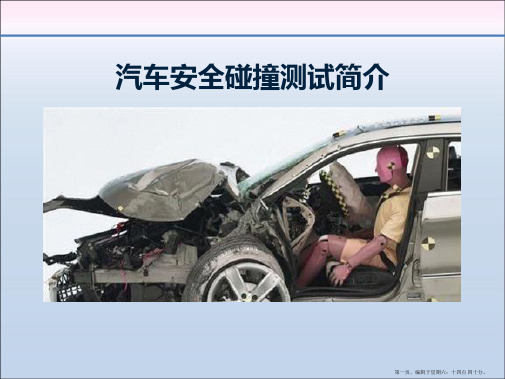
同的是,IIHS只会选择最低配车型进行测试,如果厂家有要求,可以对选装后的高配车重新测试, 但是成绩必须与低配车型一起公布。
汽车安全碰撞测试简介
第一页,编辑于星期六:十四点 四十分。
目录
1.前言 2.各国新车碰撞试验介绍
3. 中国新车评价规程C-NCAP介绍
第二页,编辑于星期六:十四点 四十分。
前言
随着人们生活水平的不断提升,汽车已经成为了普通家庭的常规用品。人们对汽 车的要求也越来越高,不仅满足于日常代步,更是个性与身份的象征。但不管对汽车 的附加功能有什么要求,安全始终是消费者对汽车的最基本要求。
行人保护评分标准:头部模型冲击共24分(成人12分、儿童12分) 大腿模型冲击共6分 小腿模型冲击共6分
第十二页,编辑于星期六:十四点 四十分。
安全辅助系统评价
Euro-NCAP 2009版标准比前标准变化最大的就是新设置 了安全辅助项目。在实际交通事故中,安全辅助设备的作用非常 大。之前的Euro-NCAP标准中只是在乘员保护方面设置了最高3分的加 分项来反映测试车型的安全配置(针对安全带提醒装置)。 随着新的安全辅助装备的不断涌入,Euro-NCAP认为这3分的加 分项已经不能满足需要了,因此把它作为了一项新的单独考核项 目。新的安全辅助项目主要由3项组成:
Euro-NCAP
(1)SBR(安全带提醒装置),测试标准和要求与以前的加分项一样,只是形式由原来的加分项变为规定项, 最高为3分(驾驶员、前排乘员及后排各1分),对于那些只有2个座椅的车,其满分为2分。
euroncap评价章程 木秀于林

Euroncap评价章程木秀于林一、引言汽车碰撞测试的标准与要求,对汽车行业具有重要的指导意义。
欧洲新车评价计划(Euro NCAP)作为汽车安全测试的权威机构,对于推动汽车安全技术的发展和提升汽车安全水平起着举足轻重的作用。
而其评价章程更是牵引着整个汽车行业的发展方向。
本文就Euro NCAP 评价章程进行深入探讨,旨在探析其对汽车行业的影响和意义。
二、Euro NCAP评价章程概况Euro NCAP成立于1997年,是欧洲汽车安全协会(European New Car Assessment Programme)的缩写。
该计划旨在推广全球范围内的汽车安全知识,提高汽车安全水平,从而减少交通事故对人员伤亡以及财产损失。
Euro NCAP评价章程是Euro NCAP制定的汽车碰撞测试和安全评价的标准和规定,它对汽车的主 pass、5星制、主被动安全、行人保护以及辅助系统等方面作出了明确的要求和评价标准。
评价章程的推出标志着该机构对汽车安全问题的高度重视和严格要求,也在一定程度上推动了汽车制造商的技术创新和产品升级。
三、Euro NCAP评价章程的影响Euro NCAP评价章程对汽车行业产生了深远的影响。
其一是推动了汽车技术的创新发展。
Euro NCAP评价章程对汽车碰撞安全、车辆pass、主被动安全、行人保护以及辅助系统等方面进行了细致的评估和要求,迫使汽车制造商在汽车设计和制造过程中更加注重安全性能,不断引入高新技术,提高汽车整体安全水平。
其二是提升了汽车产品的安全性能。
在Euro NCAP评价章程的推动下,汽车制造商均会针对测试项目进行技术改进和产品提升,不断优化产品的安全性能,加大安全设备配置力度,推出更符合用户需求和标准的安全产品。
四、Euro NCAP评价章程的意义Euro NCAP评价章程是Euro NCAP对汽车安全进行测试和评价的重要准则,其意义体现在多个方面。
Euro NCAP评价章程规定了一系列关于汽车安全的具体标准和测试方法,有助于用户更加清晰地了解汽车的安全性能,提高用户对汽车安全的重视程度。
欧洲EuroNCAP安全评价规程
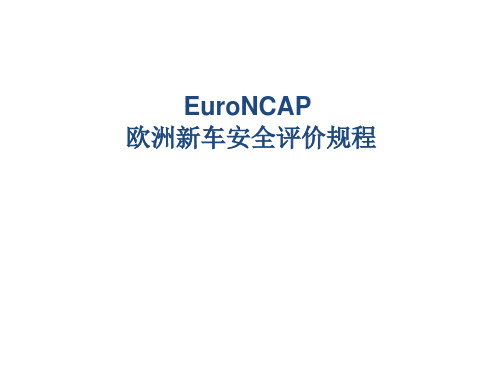
欧洲NCAP
➢ 试验项目:
64km/h正面40%偏置碰撞(1997)
50km/h侧面碰撞(1997)
29km/h侧面柱碰撞(选做)
➢ 分数构成:可以得到的最高总分:37分
40%偏置碰撞 16分
侧面碰撞 16分
侧面柱碰撞
2分
安全带提醒装置
3分
欧洲NCAP
➢总分要求: 1~8分 9~16分
17~24分 25~32分 33~37分
1 mm 1000 120 g 80 g
Assessment Criteria 评价标准
Front Impact 正面碰撞: (Overall总分: 16)
➢ Head 头
Drivers with no steering wheel airbag (Cont.) 未配置正面安全气囊的驾驶员(继续)
Adjusted 调整
Final scores in front impact 正面 碰撞中的最后得分
structural performance 结构性能: • steering wheel displacement 方向盘位移 • pedal movement 踏板移动量 • footwell distortion 搁脚处的变形 • displacement of the A pillar A柱的位移
Higher performance limit 高性能限值
Resultant peak Acc. 合成加速度峰值 Resultant Acc. 3 ms exceedence 持续3ms合成加速度值
80 g 65 g
Lower performance limit 低性能限值
Honeycomb crush 蜂窝材料压溃 HIC36 头部伤害指数 Resultant peak Acc. 合成加速度峰值 Resultant Acc. 3 ms exceedence 持续3ms合成加速度值
- 1、下载文档前请自行甄别文档内容的完整性,平台不提供额外的编辑、内容补充、找答案等附加服务。
- 2、"仅部分预览"的文档,不可在线预览部分如存在完整性等问题,可反馈申请退款(可完整预览的文档不适用该条件!)。
- 3、如文档侵犯您的权益,请联系客服反馈,我们会尽快为您处理(人工客服工作时间:9:00-18:30)。
后撞成员保护成为我们的新工作。安全/座椅工程师必须从早期造型开始带领 座椅供应商进行座椅分析及设计。 主动安全及其他新技术将直接影响星级
把ESC, SLR标准化或扩大应用范围 安全和电子电器工程师有必要经常进行新技术信息交流以便新产品的开发和应用。
车辆界面 Vehicle, 13
大腿型 Upper Legform, 6
碰撞测试 小腿型 Dynamic, Lower 24 Legform, 6
限速装置 SLD, 1 安全带提 醒SBR, 3
50kph侧面 碰撞 MDB side, 8
儿童约束 系统界面 CRS, 12
成人/儿童头 Child/Adult 电子稳定 控制 headform, ESC, 3 24
1-14 15-29 30-39 40-44 45-49 50-51
最高分
16 16 16 1.5 1 0.5
22
Partial points awarded if feature not 100 % fit 如果没有100%配置可以分开计分 Additional points will be made available in the future for newly validated safety innovations fitted to vehicles. 对未来新认证的安全辅助设备会增加分值
10
成人保护
36 points, total E-NCAP score: 50% 36分,占E-NCAP总分值50%
Pole impact now accounts for 8 points measuring 4 body regions with ES 2 Dummy. (Head only previously 2 points) (Additional challenge) 柱形碰撞现在有8分,使用ES2假人测试4个车身区域(额外挑战) Side barrier 8 points available instead of 16 侧面壁障测试由16分改为8分 Whiplash new test. Static evaluation followed by 3 sled tests 4 points available. (Additional challenge) 新头部甩动测试。静态评估加3个滑车试验,总计4分(额外挑战) Frontal offset as before 16 points. 前部偏置碰撞和以前一样16分 Change to the current sled test protocol to reduce (or eliminate ) knee modifier(s) 可以用独立的滑车试验减少或去除膝盖损伤对评分的影响
4
09年EuroNCAP公布的测试实例
5
09年EuroNCAP公布的测试实例
6
原EuroNCAP规则 Former EuroNCAP protocol
Former 原
7
为什么改变? WHY CHANGING?
各考核项相对独立: 成人保护、儿童保护、行人保护单独打分评价。 The assessment of adult, child and pedestrian protections are fragmented into 3 separate scoring systems. 社会和厂商过多注重高速碰撞成人保护,而儿童保护和行人保护没得 到应有的重视。Society and manufacturer pay much attention to adult safety in high speed impact, not enough attention to Child and Pedestrian Protection. 市场上新车高速碰撞普遍得分达到或趋近5星,E-NCAP星级间区分能 力降低。The new vehicles on the market are generally rated 5 and close to 5 stars. It is increasingly difficult for the current E-NCAP to differentiate the relative safety levels. 先进技术开发应用无法得到足够重视。The research, development and application of new technologies are not reflected into the system or duly rewarded.
14
EuroNCAP星级如何计算?
EuroNCAP计算器
15
规则的变化 EuroNCAP protocol Changing 新EuroNCAP规则 New EuroNCAP protocol
总体评分 总体星级
16
规则的变化 EuroNCAP protocol Changing
更为突出全车安全性能的平衡 成人碰撞保护 儿童保护 行人保护 主动安全及新技术 综合评价。 降低成人碰撞保护中侧面碰撞的成分 加强侧面撞柱的要求 加入后撞成员保护评价 加入主动安全及新技术评价
安全实验和分析工作量成倍增加。
19
可能的技术发展方向
成人保护 双预紧安 全带或膝 部气囊 行人保护 主动行 发动机 保险杠 人保护 罩盖 ● ● ● 后排安全 带提醒 ● 安全辅助 电子稳 定控制 ● 速度限 制 ●
20
09版C-NCAP较现行规则将发生何种变化?
9
现行EuroNCAP规则 Current EuroNCAP protocol 评价标准
Star rating criteria
子模块星级门槛
Box threshold
总星级门槛
Total Star Rating Threshold
子模块星级门槛
Box threshold
子模块星级门槛
Box threshold
12
行人保护
36 Points, total E-NCAP score: 20% 36分,占E-NCAP总分值20% Adult 4.8 kg head: 12 points 成人4.8kg头部: 12分 Child 2.5 kg head: 12 points (additional challenge) 儿童2.5kg头部:12分(额外挑战) Upper leg impact: 6 points (additional challenge) 大腿部碰撞:6分(额外挑战) Lower leg impact: 6 points 小腿部碰撞: 6分 Lower leg as Phase 1 小腿部为阶段1标准
2
内容提要
EuroNCAP 的解读
09年公布的测试实例 原EuroNCAP规则介绍 现行EuroNCAP规则介绍 规则的变化 面临的挑战
09版C-NCAP 的解读
09版C-NCAP规则介绍
3
什么是NCAP?
By law, all new car models must pass certain safety tests before they are sold. But legislation provides a minimum statutory standard of safety for new cars, it is the aim of Euro NCAP to encourage manufacturers to exceed these minimum requirements. C-NCAP将在市场上购买的新车型按照比国家现有强制性标准更严 格和更全面的要求进行碰撞安全性能测试,评价结果按星级划分并公 开发布,旨在给予消费者系统、客观的车辆信息,促进企业按照更高 的安全标准开发和生产,从而有效减少道路交通事故的伤害及损失。
17
面临的挑战 New challenge
未重视的领域
未涉及的领域
18
对安全设计有何影响?
行人保护星级提升成为我们的必须。安全工程师必须从早期外部造型开始外 形分析及改进行人保护性能,提出外形要求。 儿童保护成为我们的必须。安全工程师必须在早期内部造型时开展车体内部 安全分析和集成工作,和内饰DRE一起向儿童座椅供应商提出要求。 进一步加强侧车身强度,改进侧约束系统以满足侧面柱撞的新要求:
儿童乘员 Child occupant 20%
No protocol change 评估标准没有更改
行人保护 Pedestrian protection 20%
No protocol change 评估标准没有更改
辅助安全 Safety assist 10%
New active safety 新加主动安全
11
儿童保护
49 points , total E-NCAP score: 20% 49分,占E-NCAP总分值20% Dynamic Child restraint performance 24 points Based on in car p1.5 and p3 dummy injuries 儿童动态约束系统性能-24分,基于车内p1.5以p3假人受伤情况 Child seat to Vehicle Compatibility 12 points Fit of seat to vehicle systems and fitting instructions 儿童座椅与车辆兼容性-12分,儿童座椅安装以及安装说明 Vehicle CRS use 13 points Vehicle based warnings, airbag disable, 3 point belts etc. 车辆儿童约束系统-13分,车辆提示,气囊关闭,3点式安全带等
子模块星级门槛
Box threshold
